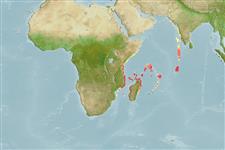>
Ovalentaria/misc (Various families in series Ovalentaria) >
Pseudochromidae (Dottybacks) > Pseudoplesiopinae
Etymology: Chlidichthys: Greek, chlidos, -eos, ous = collar, bracelet, adornment + Greek, ichthys = fish (Ref. 45335); clibanarius: The specific epithet alludes to the armourlike appearance of the body, owing to the presence of dark scale edging (Ref. 57771).
More on authors: Gill & Edwards.
Environment: milieu / climate zone / depth range / distribution range
Οικολογία
Θαλασσινό(ά) Υφαλόφιλο(α); εύρος βάθους 0 - 18 m (Ref. 57771). Tropical
Western Indian Ocean: known only from the Comoros, Aldabra (Seychelles), and
northern Madagascar.
Μέγεθος / Βάρος / Age
Maturity: Lm ? range ? - ? cm
Max length : 4.2 cm SL αρσενικό/απροσδιόριστο; (Ref. 57771)
Short description
Κλείδες προσδιορισμού | Μορφολογία | Μορφομετρία
Ραχιαίες άκανθες (συνολικά) : 2; Μαλακές ραχιαίες ακτίνες (συνολικά) : 22 - 24; Εδρικές άκανθες: 3; Μαλακές εδρικές ακτίνες: 13 - 14. Dorsal fin rays II, 22-24 (usually II, 23); anal fin rays III, 13-14 (usually III, 14); pectoral fin rays 16-18 (usually 17-18); predorsal scales 12-17, extending to interorbital commissure; ctenoid scales beginning at 1-3 transverse scale rows behind gill opening; and circumpeduncle scales 20-23, usually 20. It also has distinctive live and preserved coloration: head and body pale brown to brown (in life, pale green to olive or bright green, with yellow to bright orange or bright red stripes on head and front of body, and snout and anteroventral part of head reddish grey to bright red), with bases of scales edged with dark brown (dark olive-grey in life), giving reticulate pattern; dorsal and anal fins dark brown to dark grey basally (bluish grey to olive in life), greyish to brownish hyaline distally; scaly sheath of caudal fin similar to body coloration, edged posteriorly with dark brown to grey (olive-grey in life), remainder of fin greyish to brownish hyaline (Ref. 57771).
Collected from patch reefs, bommies and caves in drop-offs (Ref. 57771).
Life cycle and mating behavior
Γεννητική Ωρίμανση | Αναπαραγωγή | Γεννοβολία | Αβγά | Γονιμότητα | Προνύμφες
Gill, A.C. and A.J. Edwards, 2004. Revision of the Indian Ocean dottyback fish genera Chlidichthys and Pectinochromis (Perciformes: Pseudochromidae: Pseudoplesiopinae). Smithiana Bull. 3:1-52. (Ref. 57771)
IUCN Red List Status (Ref. 130435: Version 2024-1)
Threat to humans
Harmless
Human uses
Εργαλεία
Special reports
Download XML
Διαδικτυακές πηγές
Estimates based on models
Preferred temperature (Ref.
123201): 26.8 - 28.9, mean 27.6 °C (based on 169 cells).
Phylogenetic diversity index (Ref.
82804): PD
50 = 0.5001 [Uniqueness, from 0.5 = low to 2.0 = high].
Bayesian length-weight: a=0.00447 (0.00174 - 0.01147), b=3.10 (2.87 - 3.33), in cm total length, based on LWR estimates for this (Sub)family-body shape (Ref.
93245).
Τροφικό Επίπεδο (Ref.
69278): 3.3 ±0.5 se; based on size and trophs of closest relatives
Fishing Vulnerability (Ref.
59153): Low vulnerability (10 of 100).
